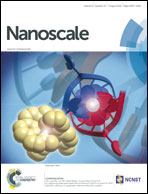Multispectral upconversion luminescence intensity ratios for ascertaining the tissue imaging depth†
Abstract
Upconversion nanoparticles (UCNPs) have in recent years emerged as excellent contrast agents for in vivo luminescence imaging of deep tissues. But information abstracted from these images is in most cases restricted to 2-dimensions, without the depth information. In this work, a simple method has been developed to accurately ascertain the tissue imaging depth based on the relative luminescence intensity ratio of multispectral NaYF4:Yb3+,Er3+ UCNPs. A theoretical mode was set up, where the parameters in the quantitative relation between the relative intensities of the upconversion luminescence spectra and the depth of the UCNPs were determined using tissue mimicking liquid phantoms. The 540 nm and 650 nm luminescence intensity ratios (G/R ratio) of NaYF4:Yb3+,Er3+ UCNPs were monitored following excitation path (Ex mode) and emission path (Em mode) schemes, respectively. The model was validated by embedding NaYF4:Yb3+,Er3+ UCNPs in layered pork muscles, which demonstrated a very high accuracy of measurement in the thickness up to centimeter. This approach shall promote significantly the power of nanotechnology in medical optical imaging by expanding the imaging information from 2-dimensional to real 3-dimensional.


 Please wait while we load your content...
Please wait while we load your content...